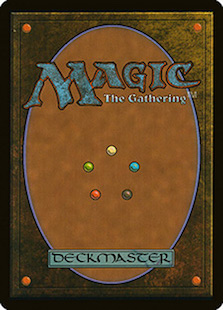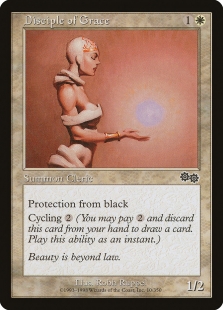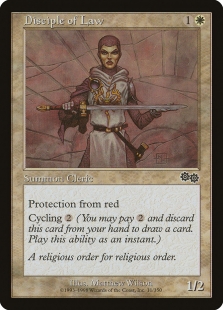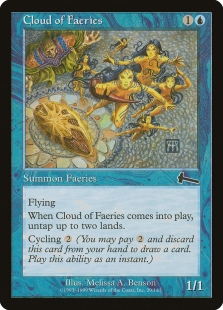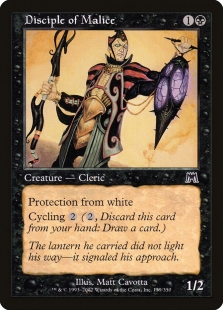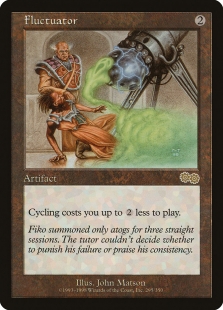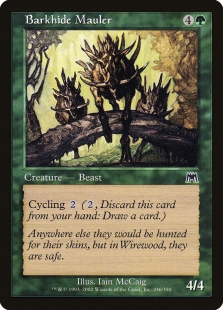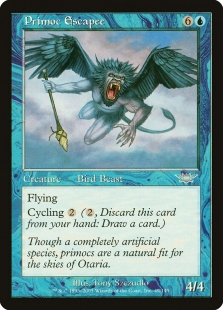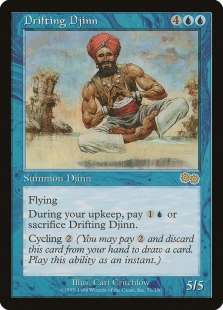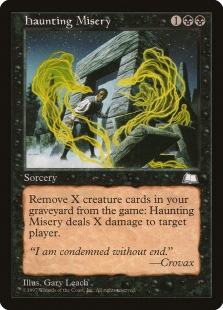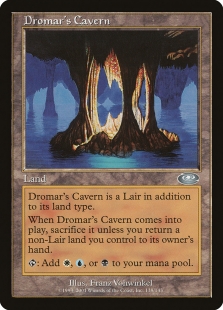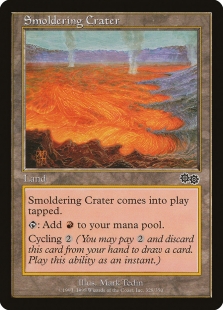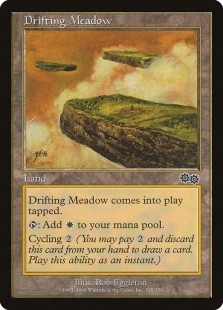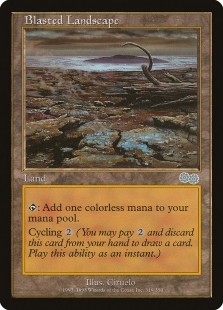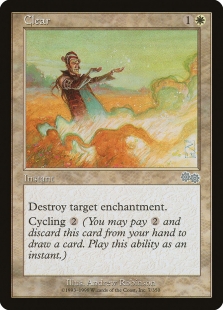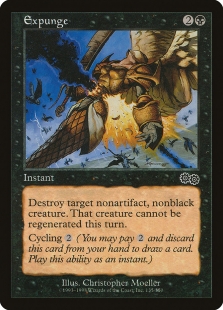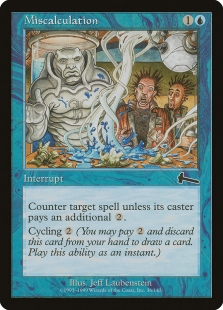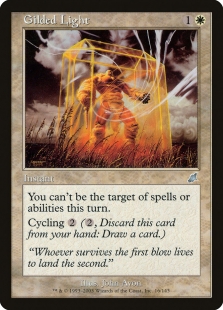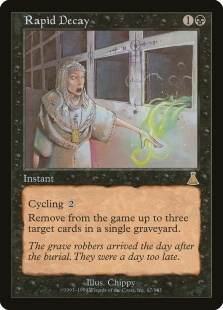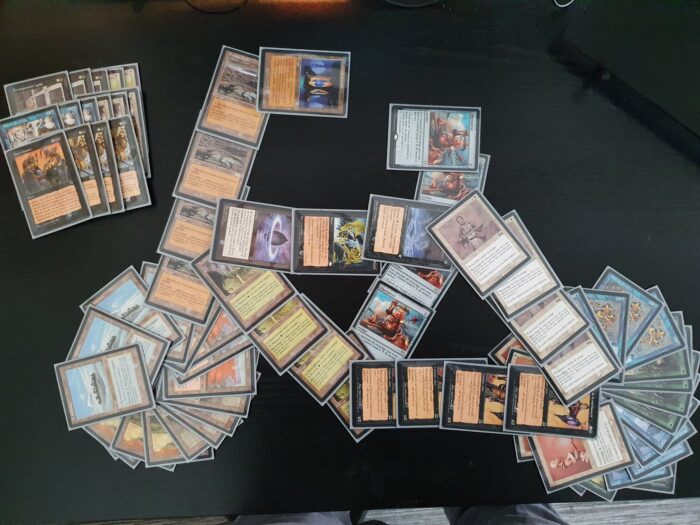Today we have a deck tech by Danny de Rooij from the Netherlands, going deep on Fluctuator. Enjoy! / Martin
Intro
Hiya nerds, my name is Danny de Rooij and I had a great idea. I got the Premodern virus from Frank Roelofs who has been crushing tourneys left and right and I wanted to feel competitive again, so I called my combo-buddy Bas de Vaan if we could make the most linear combo deck to break the format. Bas is the go-to-guy to ‘bodge’ and create code to simulate the best or fastest combo deck out there. Fluctuator seemed perfect for this. The deck is really tight on cards, has the same game plan each game and you try to minimize any form of counterplay. We wanted to get the average combo turn below turn 4.
We found a couple of decklists with great similarities. All played:
- 20 lands, some 20 cycling lands, some 19 cycling lands and 1 lair land
- 33 creatures with cycling, some with mostly cheap 1–2 drops, some with big cyclers such as Barkhide Mauler and Primoc Escapee (you had to look that up, don’t you?);
- 4 Fluctuator
- 1 Songs of the Damned, 1 Lotus Petal and 1 Haunting Misery (some play 1 Restless Dreams)
- 15 sideboard cards, some with the usual Chill, Null Rod, Duress. Some with the less-usual Stoic Champion, Enlightened Tutor, Rapid Decay, Gilded Light, Expunge and Miscalculation
We also found this previous blog post by Kyle Monson with a list that checks all boxes. The deck operates by playing Fluctuator as soon as possible, cycle through your whole deck, find the Lotus Petal, play, sac for black, cast the Songs of the Damned and cast Haunting Misery, exiling 20 creatures from your graveyard to deal lethal damage as fast as turn 2.
So we wanted to simulate the optimal possible list for comboing as soon as possible. In addition, it would hopefully tell us if we could afford to play more combo cards, like Living Death, without lowering the turn-clock, and if the first versions played the right amount of lands. We felt 20 was a potential problem which causes more mulligans. You can play a total of 24 cycling lands, but all decklists we’ve found played only 20.
The deck
After many simulations and brainstorming ideas, we settled on the following optimal decklist:
Simulator
Results after simulating 10,000,000 games
*****************************
Average Combo Turn: 3.8392
Bricked Game Percentage: 4.6866
Average Starting Hand Size 6.5152
Turn 2: 801,300
Turn 3: 4,731,388
Turn 4: 1,814,370
Turn 5: 1,094,256
Turn 6: 409,012
Turn 7: 228,163
Turn 8: 182,142
Turn 9: 148,401
Turn 10: 122,303
Brick: 468,665
*****************************
For the ones who are interested in how the simulator works and what it does:
https://github.com/Bassiuz/fluctuator-simulator/blob/master/simulate.js
We are always open to feedback on how to improve the simulator, let’s bodge together!
Comparison with a typical build
If we compare our list to the list Kyle Monson posted in 2019 (which we considered to be the best list we found), we have a couple of changes that result in the following speed gain:
- We cut the extra Drain Life in the deck for an extra cycling creature, resulting in a speed gain of 0.26 average turns;
- We upped the tapped cycling land count to 20 (4 Slippery Karst and 1 Smoldering Crater), resulting in a speed gain of 0.10 average turns;
- We removed (Miscalculation) from the main deck, resulting in a speed gain of 0.03 average turns;
- We removed the non-cycling sideboard cards (Orim’s Chant and Enlightened Tutor), which each would cost a 0.48 average turn to board in.
The speed of our deck compared to the original decklist increased 0.38 turns on average pre-board and if we include the three extra non-cycling cards it even increased by 2.26 turns on average!
Lands
The first Dromar’s Cavern is always optimal. It is an extra untapped source to combo on turn or the turn you draw that as a second land. It also won’t cost you a turn in most of your combo turns (the only time that is possible is if you are comboing after playing an untapped cycling land). Playing the second Dromar’s Cavern is worse than playing none at all, so stay at 1.
Exactly 20 tapped cycling lands is ideal in addition to the 4 Blasted Landscape and the singleton Dromar’s Cavern. Even if you had a theoretical 21st land (let’s say you could play Fetid Pools), that would not gain you any speed.
When to go off
You need to keep in mind how many non-cyclers you have in your deck left and assess if you need to go off or if you can wait. Against discard spells, it is a good idea to keep your hand full of cyclers instead of your win conditions. So if you don’t have to win in a specific turn, you can just pass the turn and wait until you have enough cyclers in hand to guarantee going off. On the other hand, if you already have a critical piece in hand, go off as fast as possible as you already lose to discard spells.
Cyclers
While it doesn’t really matter which cycling creatures you play, we advise to play as many two-drops as you can. It is suboptimal to ever play the third land, because every cycler you remove from your hand will cost you a combo turn. This also applies to your cycling creatures by the way, so there are almost no scenarios where you would play them (in game 1 to beat a Tormod’s Crypt or in a game where you drawn out a lot of cards to find the Fluctuator and need a blocker are acceptable examples).
The creatures we chose were a mix of small creatures and a couple of beaters to go with the sideboard Living Death plan. A fancy last minute inclusion is the Drifting Djinn. The Djinn can be a beating if your opponent mulligans to four cards for a specific hate card, and a singleton Djinn’s upkeep cost is payable most of the time after a resolved Living Death.
Mulligan Strategies
The general mulligan strategy is as follows:
On 7: Keep every hand with a Fluctuator and at least one land.
On 6: Keep every hand with a Fluctuator.
On 5: Keep every hand with a land.
On 4: Keep every hand.
There is a very slight change in stats when you are on the play. On the play, it is better to keep six non-lands and a Fluctuator instead of taking the mulligan. This gains you about 0.0002 average turns. This is so little, that probably the impact of actually casting a sideboard card or a creature is bigger than this extremely small speed gain.
When taking a London mulligan, please keep in mind in what order you put the cards back on the bottom. Always make sure you put cyclers on top, Fluctuators and other non-cyclers non combo pieces on the bottom, and the set of combo cards in the middle.
Sideboard cards
Notice that most sideboard cards are cyclers as well. Having non-cycling cards in your deck is a debt in your combo turn and will cost you an average of 0.48 turns for the first card! We thought about cards like Misdirection or Orim’s Chant in the sideboard, but adding in a playset would put our average turn on about turn 6.2, which is unacceptable.
The sideboard cycling cards give more versatility and can nullify your opponent’s hate cards, but they still cost you something. Every non-creature cycler will cost you about 0.03 turns, and this number grows exponentially. Cutting some main deck cycling creatures for cycling non-creatures is possible, but not free.
The sideboard cards that we view as actually usable are Clear, Expunge, Miscalculation, Gilded Light, Rapid Decay and Living Death. Other cards cost you too much combo speed to be viable. The Living Death will always be a substitute for Haunting Misery and will be the alternative win condition that way. Do not board it in as an additional card because that will cost you about 0.48 turns. The sideboard cycling cards should be swapped with an even mix of creatures and lands. If you want to sideboard 2 Rapid Decay against Reanimator, you should cut 1 Primoc Escapee and 1 Smoldering Crater.
Other considered options
Here are some other cards we considered.
Songs of the Damned vs Dark Ritual
Late in the process we figured that using Dark Ritual instead of Songs of the Damned gave our opponent the opportunity to use Tormod’s Crypt too late. Songs of the Damned screams “crack the crypt now!” whilst Dark Ritual does not. After Dark Ritual resolves, your opponent does not have time to respond to the Haunting Misery anymore with the Tormod’s Crypt. Still, Songs of the Damned is the better card. In some really fringe situations where you mulligan to five cards and still need to find Fluctuator and have four creatures in the graveyard and two lands in play, you can play Songs of the Damned, cycle once, draw the Fluctuator and still go off.
Restless Dreams
We tried a Restless Dreams setup that could make you cycle away your Fluctuators (and possible sideboard cards). We never found a consistent setup and believe it will brick you more often than it will benefit you.
Balthor the Defiled, Patriarch’s Bidding and Living Death
Balthor the Defiled was quickly dismissed due to not having enough red and black cycle creatures, such a shame. The line of adding Patriarch’s Bidding to return all cyclers of the same creature type was also an option. Unfortunately we only have 12 of the same creature type at most (Clerics). This makes Patriarch’s Bidding too inefficient. This also does not circumvent the problem of still being a graveyard deck.
Living Death is also an option and could be a viable sideboard strategy against lifegain decks that can consistently get their life total higher than 28 before turn 4, although this seems like a stretch. You could win mind games with this playing around Meddling Mage on Haunting Misery and gives you the ability to play around True Believer and Misdirection. With this option, you lose the option of casting your cheap creatures because you want the biggest ones instead. In the end, the opportunity cost of including 1 Living Death in the sideboard is low, compared to the gain of having access to an alternative win condition. After sideboarding there will surely not be any Wrath of God left in your opponent’s deck.
Stoic Champion
As an alternative to graveyard removal, we considered Stoic Champion but the double white was too much of a barrier to actually be good enough.
Drain Life
Some Fluctuator decks play Drain Life, but this seems worse. You always need two mana and thus two creatures more in the graveyard, which will cost you about 0.06 average turns for no extra gain.
Enlightened Tutor
Enlightened Tutor can make you find your Fluctuator faster. It leads to some problems, however:
- You only have five white mana sources, which is not enough to consistently cast it.
- As said before, every non-cycling card you put in your deck costs you an average of 0.48 turns. The consistency you gain by adding an Enlightened Tutor will not weigh up against the slow down you get in your combo turns.
So there you have it! It was a blast thinking about all options and trying to get the combo turn as low as possible. We hope this gives some insight about the most all-in glass canon deck of Premodern. It’s really really fast, but it tends to lose on the spot to good sideboard cards. Roll a die, try to embrace your inner Lance Armstrong and keep cycling on steroids to win the day. Hopefully nobody will play Stabilizer in their deck anytime soon.
– Danny
